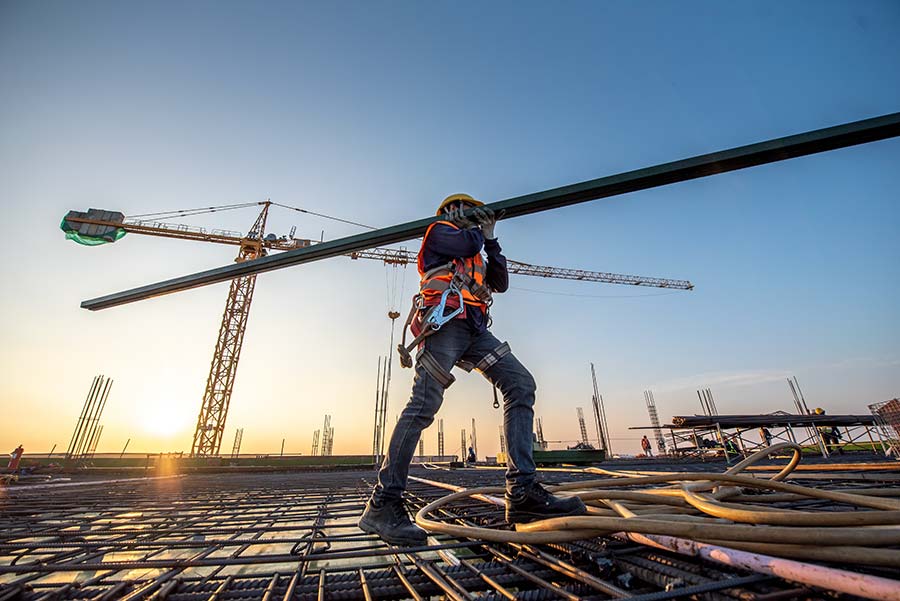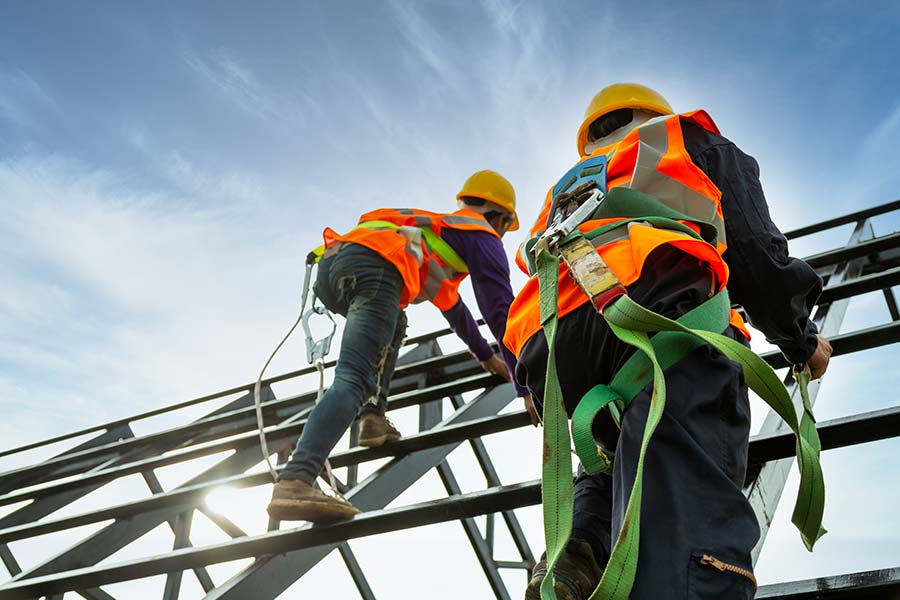Construction Accidents
Thankfully, many of these injuries fall under the workers’ compensation coverage umbrella, meaning that affected workers could be eligible for compensation encompassing medical expenses, disability benefits, and additional damages. At Steve Crane Law, attorney Steve Crane and his team bring a collective experience spanning decades dedicated to assisting injured employees and their families with diverse workers’ compensation claims.
Schedule a free, no-obligation consultation today to review your case and determine your legal options. Attorney Steve Crane believes in protecting the rights of injured workers and will work hard to obtain the compensation you deserve. If you decide to move forward, there are no upfront costs or fees to worry about. You only pay us if we help you recover fair compensation.
Since 1995, attorney Steve Crane has successfully represented persons like you.
As an experienced lawyer, Steve can gauge when it makes sense to go to court. He knows that a letter or phone call — with proper wording and timing — can be more effective or cost-efficient than suing for damages or injunctive relief.
For those cases that must be presented to a judge or jury, he is eminently qualified to assert your interests.
If you have sustained injury due to a construction accident, call attorney Steve Crane free. He and his team can assess the facts of your case and help you determine the best course of action to move forward.
To schedule a discrete and confidential consultation about your matter, call attorney Steve Crane free at (888) 855-4400.
Types of construction accidents
From falls to equipment malfunctions, construction accidents can vary widely in cause and consequence. We have the expertise and resources to handle a broad spectrum of construction accident cases:
- Slip and fall accidents – These accidents are caused by a variety of things, from slippery, uneven surfaces or holes in the ground to unstable ladders or scaffolding. Workers can slip on wet surfaces, trip over tools, or fall from windows or roofs. This can result in severe or even fatal injuries.
- Overexertion accidents – These accidents are caused by hours of hard labor, usually in hot and humid weather conditions. Workers can overexert themselves and sustain a heat stroke or suffer a back injury from doing a lot of heavy lifting.
- Falling materials accidents – Tools, machinery, steel beams and other items can fall from different heights and cause serious injuries to workers below.
- Explosions and burns – Unfinished piping, leaking gases, or electric systems being worked on can cause fires and explosions on the job site. Workers can become severely burned or disfigured.
- Electrocution accidents – These accidents are caused by exposed wiring, power lines, and unfinished electrical systems, which can result in electrocution or shock.
- Forklift accidents – These accidents are caused by speeding, improper training, and inattentive operation. A forklift can strike or crush workers, resulting in serious personal injuries.
- Trench Collapses – Incidents where workers are trapped or injured in excavations.
- Automobile collisions – Construction sites are often located next to roads or highways, which can be very dangerous. Workers can be hit by cars passing by the job site. These accidents are commonly caused by distracted or inattentive drivers.
- Crane accidents – Lack of inspections, overloading, improperly trained employees, and improper crane setup can result in cranes hitting workers with heavy objects and materials or colliding with power lines and buildings.
- Machinery accidents – These accidents are caused heavy machinery commonly found on construction sites. Workers can be pinned against the ground or wall by heavy machines or be injured using a jackhammer or nail gun.
- Equipment and Machinery Malfunctions – Injuries resulting from defective or improperly operated machinery. Workers can be pinned against the ground or wall by heavy machines or be injured using a jackhammer or nail gun.
- Chemical Exposure – Illnesses or injuries from hazardous chemicals or materials on-site.

California workers’ compensation claims
Calfiornia law requires all construction firms to carry workers’ compensation insurance. This insurance can be obtained through an insurance company or by means of self-insurance. Should an employee experience an injury or illness related to their work, they are entitled to receive workers’ compensation benefits. These benefits encompass medical expenses and lost wages, providing support during periods of total or partial disability.
Furthermore, individuals might also qualify for supplementary job displacement benefits, aimed at aiding in covering the costs of retraining and education if they need to transition to a different occupation due to their disability. In the unfortunate event of a worker’s demise stemming from a work-related injury or illness, death benefits may be available to provide compensation for the loss of financial support.
It’s worth noting that workers’ compensation is accessible to employees irrespective of liability for the injury. Nevertheless, certain scenarios are excluded from workers’ compensation coverage. Instances such as injuries caused by substance abuse or violations of workplace safety regulations might render individuals ineligible for benefits.
To strengthen the case that the injuries were sustained in the course of employment, one effective approach is to promptly seek medical attention by visiting a hospital or doctor’s office. Simultaneously, notifying the employer about the construction accident as soon as feasible is crucial. By taking these actions, it becomes significantly more challenging for the employer to contend that the injury is unrelated to the job responsibilities.

Deadlines for workers’ compensation claims in California
When it comes to initiating a workers’ compensation claim in California, specific timeframes need to be observed.
The deadlines for filing workers’ compensation claims in California can vary depending on the nature of the injury or illness. Generally, reporting a work-related injury or illness to your employer is crucial as soon as possible. Failing to meet the deadlines may affect your ability to receive benefits. Here are some key timelines to keep in mind:
Notice to Employer: You have 30 days to tell your employer about your injury.
Filing the Claim: You have one year from the date of the injury to file a claim with the State Workers’ Compensation Board.
While these are general guidelines, specific situations may have different timelines. It’s important to consult with a workers’ compensation attorney to ensure you meet all the necessary deadlines and requirements. An attorney can provide guidance based on the details of your case and help you navigate the workers’ compensation process in California.
Failure to adhere to this reporting window might result in a forfeiture of your entitlement to benefits.
Once your employer is notified of the injury, they must furnish you with a claim form within one day. Subsequently, you have a one-year period from the date of your injury to formally file a claim. Prompt reporting and filing expedite the process and minimize the likelihood of your employer or their insurance provider disputing the work-related nature of the injury or questioning your motives for seeking compensation. This proactive approach could significantly enhance your prospects of securing rightful compensation.
Navigating the intricacies of filing a workers’ compensation claim can be intricate, especially without an in-depth grasp of state laws and regulations. We are adept at elucidating the application of the law to your specific circumstances, safeguarding your rights in the process. We are fully equipped to offer comprehensive guidance, assisting you from the initial claim submission to representing your interests during the appeals process should you encounter benefit denials or receive insufficient compensation.
At Steve Crane Law, attorney Steve Crane and his team possess the proficiency and resources to thoroughly investigate your situation, uncovering additional evidence that might bolster your appeal and augment your chances of a successful outcome.
If you have sustained a workplace injury, call attorney Steve Crane free. He and his team can assess the facts of your case and help you determine the best course of action to move forward.
To schedule a discrete and confidential consultation about your matter, call attorney Steve Crane free at (888) 855-4400.

Workers’ compensation claims against third parties
Employees are typically barred from suing their employers for work-related injuries or illnesses. However, when injuries stem from the negligence of a third party—an entity distinct from the employer—there exists the possibility of pursuing a claim against that third party.
Possible parties that might bear responsibility as third parties include:
- Engineers
- General contractors
- Architects
- Subcontractors
- Property owners
- Equipment suppliers
- Product manufacturers
Third parties can be implicated in construction accidents in various ways, rendering them liable. For instance:
- If a negligent driver in another vehicle causes injury while you’re operating a construction vehicle for work, you could have grounds to file a claim against that driver.
- If faulty equipment leads to an error while operating heavy machinery, resulting in severe injuries, you might be entitled to file a claim against the equipment manufacturer.
- Should negligence by a subcontractor or general contractor under whom you’re employed cause significant harm, a claim against the contractor might be viable.
Unlike workers’ compensation claims, third-party claims encompass diverse forms of compensation, including physical and emotional pain and suffering. Comparable to workers’ compensation claims, you can also seek redress for medical expenses, lost wages, and diminished earning capacity through a third-party claim.
A distinguishing factor between third-party and workers’ compensation claims lies in the requirement to prove negligence as a factor in the injury. Negligence is relevant only to third-party claims but doesn’t factor into workers’ compensation claims. Through a comprehensive investigation, our legal professionals can assist you in accumulating evidence to demonstrate the lack of reasonable care exercised by the third party, resulting in your injuries.
In California, if a third party (someone other than your employer or a co-worker) is responsible for your work-related injury, you may have the option to pursue a third-party claim in addition to your workers’ compensation claim. The statute of limitations for third-party claims differs from the timeframes associated with workers’ compensation claims.
Third-party claims fall under the category of personal injury lawsuits, thereby subject to California statute of limitations.
For third-party claims in California:
- Personal Injury Lawsuit: If you are considering filing a personal injury lawsuit against a third party, California generally has a two-year statute of limitations for personal injury cases. This means you typically have three years from the date of the injury to file a lawsuit against the responsible third party.
- Discovery Rule: In some cases, the statute of limitations may be calculated from the date you discovered or should have discovered the injury. This is known as the discovery rule and may apply to cases where the injury is not immediately apparent.
It’s crucial to consult with a personal injury attorney to get accurate and up-to-date information about the specific deadlines for your situation. They can assess the details of your case, explain the applicable laws, and guide you on the best course of action. Keep in mind, failing to meet the statute of limitations may result in permanently losing your right to pursue a third-party claim.

Why trust Steve Crane Law to handle your construction accident case?
Experience: Our team of skilled attorneys has successfully represented construction workers in a wide array of accident cases, winning substantial settlements and verdicts.
Attention to Detail: We conduct thorough investigations, collaborate with experts, and gather evidence to build a robust case.
Client-Focused: Your well-being is our priority. We provide individualized attention, always keeping you informed and involved in your case.
Risk-Free Consultation: Reach out to us for a free, no-obligation consultation to discuss your case and potential avenues for compensation.
Contingency Fees: We operate on a “No Win, No Fee” basis. You won’t pay a dime unless we secure compensation for you.
If you have sustained a workplace injury, call attorney Steve Crane free. He and his team can assess the facts of your case and help you determine the best course of action to move forward.
To schedule a discrete and confidential consultation about your matter, call attorney Steve Crane free at (888) 855-4400

Time is of the essence. Do not wait to file a claim.
Under California’s statute of limiations, individuals who have suffered injuries have a two-year window starting from the date of the injury to initiate a personal injury claim, seeking compensation for the array of damages resulting from the accident.
However, the window could be much shorter than two years. It all depends on the facts surrounding the incident giving rise to injuries. Failing to take legal action within this specified timeframe renders victims unable to pursue a claim.
California law provides specific time limits for filing lawsuits, called statutes of limitations.
These laws were enacted to ensure that lawsuits are started quickly after an incident, when evidence is more easily accessible, and witness memories are more reliable. In general, once the statute of limitations period for a case has run, the legal claim can no longer be pursued.
The statute of limitations is different for each type of case. To determine the statute of limitations for your case, you must determine your cause of action, which is the legal reason for suing. The statutes of limitation for many, but not all, types of civil cases are found in the California Code of Civil Procedure (CCP) §§ 312-365.
The statutes of limitations for several types of common civil actions in California include:
- Personal injury or wrongful death: 2 years (CCP § 335.1)
- Damage to personal property: 3 years (CCP § 338)
- Breach of a written contract: 4 years (CCP § 337)
- Breach of an oral contract: 2 years (CCP § 339)
If a case is filed past the date set by a statute of limitations, the defendant may raise this as an affirmative defense or as grounds for a demurrer. The court has no leeway on statute of limitation issues. If the case is filed past the date set by the statute of limitations, it must be dismissed. However, it is not always obvious when the statute of limitations period begins or ends.
Research is often required to determine the exact date a statute of limitations began to run. A statute of limitations begins to run when a cause of action “accrues” (CCP § 312). Generally, a cause of action accrues on the date of injury or the date the incident occurs. If a cause of action has multiple elements, the statute of limitations accrues when the final element occurs.
In some cases, determining the date of accrual can be complicated. Occasionally, accrual is postponed until the plaintiff discovers, or should have discovered the injury. For example, the statute of limitations for medical malpractice is three years from the date of the injury or one year from the date the plaintiff discovers or reasonably should have discovered the injury, whichever occurs first. Some medical mistakes may not cause any noticeable after-effects and may go undetected for years until discovered during tests for an unrelated condition. In these types of situations, the patient could not reasonably discover the injury until long after the three-year period for filing after injury. However, the patient would likely be able to file a lawsuit within one year of discovering the injury. However, if the medical mistake resulted in a noticeable after-effect, such as unusual pain, and the patient did not seek medical attention to discover the source of the pain, the patient would likely be barred from filing past the three-year period, because he should have reasonably discovered the injury much sooner. Delayed discovery is not common. In most situations, reasonable diligence will reveal that a party has been injured.
Determining when the statute of limitations expires can also be a bit tricky. The running of the statute of limitations is “tolled,” or suspended, in certain circumstances. CCP §§ 350-363 describe specific instances in which a statute of limitations is tolled. The most common of these are related to a legal status that prevents the plaintiff from starting a case, such as being a minor or being mentally incompetent. The statute of limitations begins to run when that legal status ends, such as on a minor’s 18th birthday.
In other cases, though, the statute of limitations is tolled under the doctrine of “equitable tolling,” rather than by a specific code section. Equitable tolling is a legal theory that ensures plaintiffs are not prevented from filing a lawsuit simply because they sought an alternative form of relief first.
Equitable tolling generally applies when an injured person has several legal remedies and pursues one reasonably and in good faith. For example, the statute of limitations for a personal injury action may be tolled under the theory of equitable tolling during an ongoing workers’ compensation claim for the same injury. The statute of limitations for filing a personal injury case is two years. However, filing a workers’ compensation claim may pause, or toll, the clock on the injured person’s civil case. fterf the workers’ compensation process, the civil clock picks up where it left off. The statute of limitations will expire at the end of whatever time remains of the two-year statute of limitations.
Do not automatically assume that your statute of limitations is tolled! Determining whether a statute of limitations is tolled usually requires a lot of research into the type of case you’re handling. A list of suggested resources for conducting research is at the end of this Guide.
To ensure you do not forfeit your right to file a claim, we strongly advise contacting our law firm at your earliest convenience to schedule a consultation. Act promptly to protect your legal rights and explore your options for seeking the compensation you deserve.
If you have sustained a personal or workplace injury, call attorney Steve Crane free. He and his team can assess the facts of your case and help you determine the best course of action to move forward.
To schedule a discrete and confidential consultation about your matter, call attorney Steve Crane free at (888) 855-4400
QUICK LINKS
PRACTICE AREAS
Client Testimonials
After my accident on the construction site, I felt lost and overwhelmed. Steve Crane Law stood by my side, fighting for my rights every step of the way.
Carlos P.
Steve is a genuine champion for construction workers. His dedication ensured that I received the compensation I needed to get my life back on track.
Aisha L.
